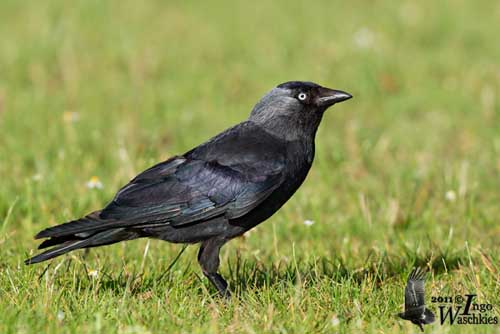
Fr: Choucas des tours
All : Dohle
Esp: Grajilla Occidental
Ital : Taccola
Nd: Kauw
Sd: Kaja
Photographers:
José Luís Beamonte
Pájaros de España
Steve Garvie
RAINBIRDER Photo galleries
Ingo Waschkies
Bird Photography
Nicole Bouglouan
PHOTOGRAPHIC RAMBLE
Text by Nicole Bouglouan
Sources:
HANDBOOK OF THE BIRDS OF THE WORLD Vol 14 by Josep del Hoyo-Andrew Elliot-David Christie - Lynx Edicions – ISBN: 9788496553507
BIRDS OF THE MIDDLE EAST by R.F. Porter, S. Christensen, P Schiermacker-Ansen C.Helm - ISBN: 0713670169
ENCYCLOPEDIE DES OISEAUX DE FRANCE ET D’EUROPE – de Peter Hayman et Rob Hume - Flammarion – ISBN : 2082009920
L’ENCYCLOPEDIE MONDIALE DES OISEAUX - Dr Christopher M. Perrins - BORDAS - ISBN: 2040185607
THE COMPLETE BOOK OF BRITISH BIRDS – Written by “Royal Society for the Protection of Birds” experts - Préface de Magnus Magnusson - Michael Cady- Rob Hume Editors - ISBN: 0749509112
BirdLife International (BirdLife International)
Wikipedia, the free encyclopaedia
Eurasian or Western Jackdaw
Corvus (Coloeus) monedula
Passeriforme Order – Corvidae family
BIOMETRICS:
Length: 34-39 cm
Weight: 136-265 g
DESCRIPTION:
The Eurasian or Western Jackdaw differs from other Corvus species by its nesting behaviour. This species is cavity-nester whereas other Corvidae build stick nests.
The adult has blackish forecrown slightly washed glossy bluish. Hindcrown, nape and head sides are pale grey. The nominate race shows whitish nuchal collar.
The upperparts are dark grey with weak bluish tinge. Upperwing and tail are darker.
The underparts are dark grey.
Bill, legs and feet are black. The eyes are pale greyish-white.
Both sexes are similar.

The juvenile has head and body plumage tinged brownish and it lacks the bluish gloss. The eyes are dark brown until the end of the first winter. The young is sexually mature at two years of age.
We can find four subspecies:
C.m. monedula (here described) is found in Scandinavia.
C.m. spermologus (here displayed) is found in W and C Europe, from British Islands to Morocco and NW Algeria.
This one has darker plumage than nominate, with blacker face, lores and throat, and lacks the pale nuchal collar or has indistinct greyish-white line at neck base.
C.m. cirtensis is found in NE Algeria.
This race is uniformly slate-grey with less contrast on head and nape.
C.m. soemmerringii occurs in E Europe, in Asia to L Baikal, W China and Kashmir.
This one is paler than “monedula” and “spermologus”, especially on nape, and shows distinct pale collar ending in wide whitish patch at neck side in S and E populations.
VOICE: SOUNDS BY XENO-CANTO
The Eurasian or Western Jackdaw’s typical call is a loud, high-pitched, almost metallic “chjak” uttered singly or repeated 7 or 8 times when the birds are excited while forming large flocks.
We can also hear other calls such as a low, drawn “chaairr” often accompanied by a “chak”, and a slurred, high “kyow”.
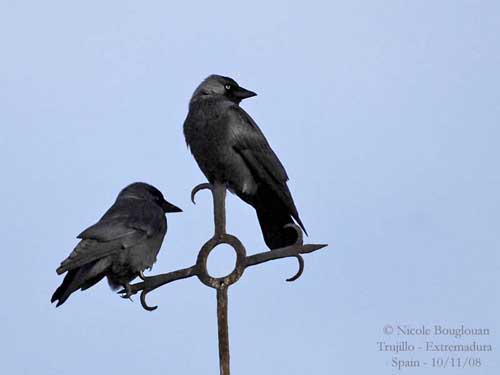
HABITAT:
The Eurasian or Western Jackdaw can be found in various open country areas if scattered trees are present. It frequents farmlands, parks and gardens, monument yards, wooded steppes, coastal cliffs and quarries, and also towns and villages.
It usually avoids treeless country and large forests. This species is visible up to 2000 metres in some Asian regions and in Morocco. Non-breeding birds may occur up to 3500 metres of elevation in Kashmir.
RANGE:
See above in “subspecies”.
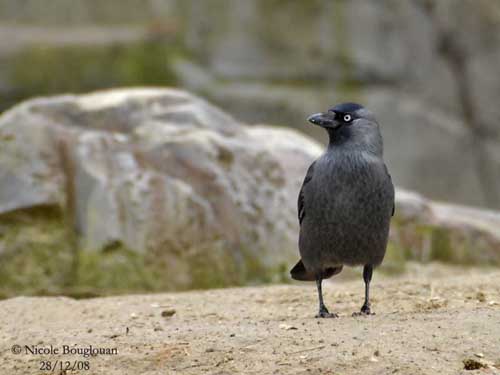
BEHAVIOUR:
The Eurasian or Western Jackdaw is omnivorous but it takes more plant materials than other scavengers. Its diet includes grain, seeds and berries. However, during the breeding season, it becomes more carnivorous, feeding on a wide variety of invertebrates. Some individuals may take bird eggs, including that of fairly large birds such as Atlantic Puffin and Eurasian Collared Doves.
The Eurasian or Western Jackdaw, as all Corvidae species, is very smart and its ingenuity allows the species to feed and survive easier.
They forage along the tideline, at picnic sites and in urban parks. It feeds mainly on the ground where it walks with strutting gait while searching for food.
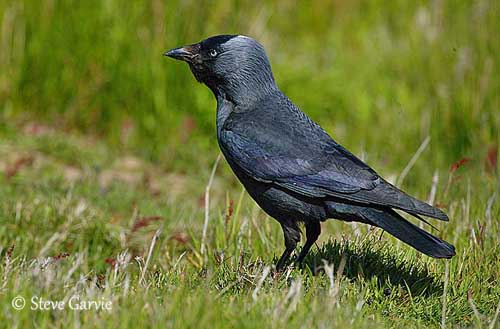
It may perch on mammals to feed on ectoparasites. It also catches flying ants on the wing during insect emergences.
Piracy is also another way for feeding. It pursues other birds and makes them drop their prey items.
The Eurasian or Western Jackdaw is a gregarious species and often forms mixed flocks with other Corvidae when they forage in fields and even at roosts.

They are often seen in small flocks on cliff faces and monuments towers.
They breed in holes, often in loose colonies, but they may build nests in more open sites if cavities are not available.
The nest-site is defended all year round by resident pairs, but when a colony is established on a cliff, all the birds take part in defence against the predators.

They communicate through numerous visual and acoustic signals and displays. Threat, defence, greeting, courtship, submissive and begging displays are very similar to that of other passerine groups. The commonest defence display shows the bird with fluffed out feathers and fanned tail.
Most populations are resident in their range or short-distance migrant. But the northernmost populations move in order to spend the winter where food resources are abundant.
FLIGHT:
The Eurasian or Western Jackdaw has more direct flight and performs more rapid wingbeats than other crows. The wings are less fingered compared to other Corvidae.

REPRODUCTION:
The breeding season occurs in spring, with the laying from mid-April to first half of May.
Male and female build the nest, usually in cavity such as rock crevice in quarry or cliff face, tree hole, abandoned burrow, hole in chimney, monument or bridges. Nest foundation is a mass of branches and twigs, associated to mud and dung. The inner cup is deep with thick lining of moss, rotten wood, feathers, fur and wool (The Eurasian or Western Jackdaw is often seen taking hair from live mammals). The same nest-site is reused year after year.
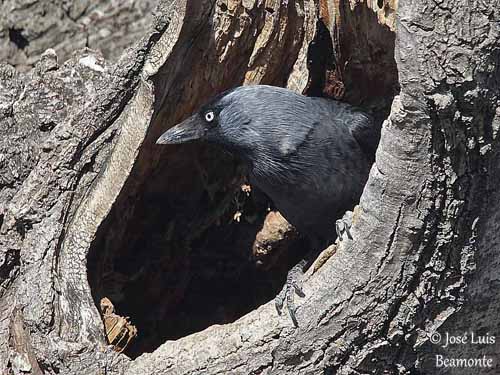
The female lays 3-8 eggs, usually 4. She incubates alone during 17-19 days. The chicks are fed by both parents and leave the nest about one month after hatching. The family group joins up with other families and form summer flocks.
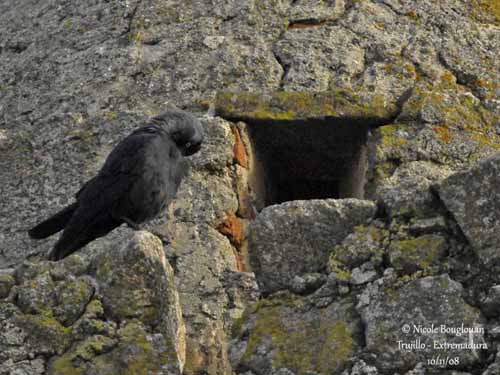
DIET:
The Eurasian or Western Jackdaw feeds on a wide variety of food, including invertebrates in summer diet such as Orthoptera, Formicidae, Diptera, Coleoptera and moth-caterpillar such as Tortrix viridana.
PROTECTION / THREATS / STATUS:
The Eurasian or Western Jackdaw is abundant in most part of the range, but decreases have been reported in most European countries over recent decades, probably due to persecutions.
However, the species is not currently threatened.
